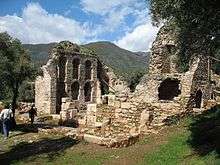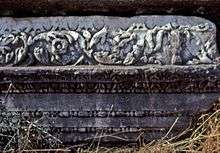Nysa on the Maeander
| Νῦσα (in Greek) | |
|
The theatre of Nysa | |
 Shown within Turkey | |
| Location | Sultanhisar, Aydın Province, Turkey |
|---|---|
| Region | Caria |
| Coordinates | 37°54′06″N 28°08′48″E / 37.90167°N 28.14667°ECoordinates: 37°54′06″N 28°08′48″E / 37.90167°N 28.14667°E |
| Type | Settlement |
Nysa on the Maeander was an ancient city and bishopric of Asia Minor (now Anatolia, Asian Turkey), whose remains are in the Sultanhisar district of Aydın Province of Turkey, 50 kilometres (31 mi) east of the Ionian city of Ephesus, and which remains a Latin Catholic titular see.
At one time it was reckoned as belonging Caria or Lydia,[1][2] but under the Roman Empire it was within the province of Asia, which had Ephesus for capital, and the bishop of Nysa was thus a suffragan of the metropolitan see of Ephesus.[3][4][5]
History
In Greek mythology, Dionysus, the god of wine was born or raised in Nysa or Nyssa (Ancient Greek: Νύσα or Νύσσα), a name that was consequently given to many towns in all parts of the world associated with cultivation of grapes.[2] The name "Nysa" is mentioned in Homer's Iliad (Book 6.132-133), which refers to a hero named Lycurgus, "who once drove the nursing mothers of wine-crazed Dionysus over the sacred mountains of Nysa". But the city on the Maeander was named instead for Nysa, a wife of Antiochus I Soter, who reigned from 281 to 261 BC and founded the city on the site of an earlier town called Athymbra (Ancient Greek Ἄθυμβρα), a name that continued in use until the second half of the 3rd century BC, but not in the earliest coinage of Nysa, which is of the next century.[1][6]

The geographer Strabo began his studies under the rhetorician Aristodemus of Nysa the Younger, a grandson of the famous Posidonius, whose influence is manifest in Strabo's Geography. Nysa was then a centre of study that specialized in Homeric literature and the interpretation of epics.
Nysa was ruled by the Hellenistic Seleucid Empire, the Roman Empire and its continuation, the Byzantine Empire and by the Turks, until its final abandonment after being sacked by Tamerlane in 1402.
Ecclesiastical history
Nysa became a suffragan of its provincial capital's metropolitan Archdiocese of Ephesus, I the sway of the Patriarchate of Constantinople. Of the Byzantine bishops of Nysa in Asia, several are historically documented:[3][4][5]
- Theodotus took part in the Council of Ephesus (431)
- Maeonius in the Council of Chalcedon (451)
- Sisinnius in the Third Council of Constantinople (680) and the Trullan Council (692)
- Theodosius in the Second Council of Nicaea (787)
- Nicholaus in the Council of Constantinople (869)
- Michael in the 'Photian' Council of Constantinople (879) on the fate of Patriarch Photius I of Constantinople.
Titular see
The diocese was nominally restored in 1933 as Latin Titular bishopric of Nysa in Asia (Latin) / Nisa di Asia (Curiate Italian) / Nysæus in Asia (Latin adjective),[7] of the Episcopal (lowest) rank, but it remains vacant, never having had an incumbent.
Remains

There are important ruins on the site from the Hellenistic, Roman, and Byzantine periods. The well-preserved theatre, built during the Roman Imperial period, is famous for its friezes depicting the life of Dionysus, god of the grape harvest, winemaking and wine. It has a capacity 12.000 people. The library dating from the 2nd century A.D. is considered to be Turkey's second-best preserved ancient library structure after the "Celsus Library" of Ephesus. The stadium of Nysa, which suffered from floods and is therefore partially damaged, has a capacity of 30,000 people. The bouleuterion (municipal senate), later adapted as an odeon, with 12 rows of seats, offers room for up to 600-700 people. Other significant structures include the agora, gymnasion and the Roman baths. The 100 m long Nysa Bridge, a tunnel-like substructure, was the second largest of its kind in antiquity.[8]
See also
- List of Catholic dioceses in Turkey
- Nysa (disambiguation) for (near-)namesakes
References
- 1 2 Bean, G.E. (1976). The Princeton Encyclopedia of Classical Sites. Tufts University, Princeton, N.J. Retrieved 29 January 2015.
- 1 2 Smith, William. "Dictionary of Greek and Roman Geography (1854)". Perseus. Retrieved 29 January 2015.
- 1 2 Michel Lequien, Oriens christianus in quatuor Patriarchatus digestus, Paris 1740, Vol. I, coll. 705-708
- 1 2 Pius Bonifacius Gams, Series episcoporum Ecclesiae Catholicae, Leipzig 1931, p. 444
- 1 2 Pascal Culerrier, Les évêchés suffragants d'Éphèse aux 5e-13e siècles, in Revue des études byzantines, vol. 45, 1987, p. 158
- ↑ Getzel M. Cohen, The Hellenistic Settlements in Europe, the Islands, and Asia Minor (University of California Press, 1996: ISBN 0-520-08329-6), p. 257.
- ↑ Annuario Pontificio 2013 (Libreria Editrice Vaticana 2013 ISBN 978-88-209-9070-1), p. 941
- ↑ Klaus Grewe, Ünal Özis et al.: "Die antiken Flußüberbauungen von Pergamon und Nysa (Türkei)", Antike Welt, Vol. 25, No. 4 (1994), pp. 348–352 (352)
Sources and external links
| Wikimedia Commons has media related to Nysa (Caria). |
- Bibliography - ecclesiastical history
- Pius Bonifacius Gams, Series episcoporum Ecclesiae Catholicae, Leipzig 1931, p. 444
- Michel Lequien, Oriens christianus in quatuor Patriarchatus digestus, Paris 1740, Vol. I, coll. 705-708
- Pascal Culerrier, Les évêchés suffragants d'Éphèse aux 5e-13e siècles, in Revue des études byzantines, vol; 45, 1987, p. 158
Further reading
- Walther von Diest: Nysa ad Maeandrum, nach Forschungen und Aufnahmen in den Jahren 1907 und 1909, Reimer, Berlin 1913 (Jahrbuch des Kaiserlich Deutschen Archäologischen Instituts, Erg.-Heft 10)
- Vedat İdil: Nysa ve Akharaka = Nysa and Acharaca, Istanbul 1999, ISBN 975-6934-04-2
- Musa Kadioğlu, 'Die scaenae frons des Theaters von Nysa am Maeander. Diss. University of Freiburg im Breisgau 2002
- Musa Kadıoğlu: Die Scaenae Frons des Theaters von Nysa am Mäander. von Zabern, Mainz 2006. (Forschungen in Nysa am Mäander; 1) ISBN 3-8053-3610-1.
- Musa Kadıoğlu, Der Opus Sectile-Boden aus dem Gerontikon-Bouleuterion von Nysa ad Maeandrum, in: Asia Minor Studien, Band 34, 1999, 175-188. Taf. 34-35; in Turkish: “Menderes Nysası Bouleuterion-Gerontikon'u Opus Sectile Döşemesi”, in: Türk Arkeoloji ve Etnografya Dergisi, 1, 2000, 9-16.
- Musa Kadıoğlu – Philip von Rummel, Frühbyzantinische Funde aus dem Theater von Nysa am Maeander, in: Anadolu/Anatolia 24, 2003, 103-119
- Musa Kadıoğlu, Zwei korinthische Kapitelle aus Nysa am Mäander, in: C. Özgünel – O. Bingöl – V. İdil – K. Görkay – M. Kadıoğlu (Hrsg.), Cevdet Bayburtluoğlu için yazılar / Essays in Honour of C. Bayburtluoğlu. Günışığında Anadolu / Anatolia in Daylight (2001) 156-161.
- Vedat İdil – Musa Kadıoğlu, 2003 Yılı Nysa Kazı ve Restorasyon Çalışmaları, in: KST 26.1, 2004 (2005) 387-400.
- Vedat İdil – Musa Kadıoğlu, 2004 Yılı Nysa Kazı ve Restorasyon Çalışmaları, in: KST 27.2, 2005 (2006) 131-146.
- Musa Kadıoğlu, Menderes Nysası’ndan Bir Kantar / Eine Schnellwaage aus Nysa am Mäander, in: E. Öztepe – Musa Kadıoğlu (Hrsg.), Patronvs. Coşkun Özgünel’e 65. Yaş Armağanı / Festschrift für Coşkun Özgünel zum 65. Geburtstag (2007) 229-235
- Vedat İdil – Musa Kadıoğlu, “2005 Yılı Nysa Kazı ve Restorasyon Çalışmaları“, in: KST 28.1, 2006 (2007) 647-670